David Fincher: Fighting the Odds

Although he has so far directed only a handful of feature films, David Fincher has quickly become one of Hollywood’s most influential directors and a common name in many film fans’ vocabulary. Most moviegoers became familiar with the name David Fincher after the release of “Alien 3.” Hitting harsh criticism by critics and fans alike, many suggested director David Fincher’s visual style were too consummate and fast-paced as a result of his origins in the music video industry. And although David Fincher is the first to admit that “Alien 3” had its fair share of problems, it lay the foundation for what was to come. More determined than ever, Fincher approached his next project for New Line Cinema, and dove into the abyss of the criminal psyche, creating one of the most oppressive and morbid thrillers Hollywood had ever seen—“Se7en.”
Not only did the movie make it clear that Fincher could easily transcend his MTV video roots and create a gnawing, dark thriller that builds on suspense, he also managed to prove to the world that he was capable of creating a unique look that goes hand in hand with the subject matter. “Se7en” has reached cult status as we all know and after a series of highly successful films, including the noir thriller “The Game,” Fincher’s latest coup is “Fight Club,” a disturbing and powerful look at the state of our society.
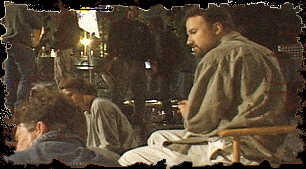 David Fincher started working in the film industry at the age of 18 when he applied for a job at George Lucas’ “Industrial Light and Magic.” At this young age, he was already working on films such as “Return Of the Jedi” and “Indiana Jones.” But to contain my wondering, the role he was playing on those productions was much less glorious than you would expect, as he tells me. “When you’re loading cameras and sweeping the stage, it is actually pretty easy to get involved into such huge projects,” David Fincher tells me with a laugh. “I didn’t have much responsibility on those shows, really. I was the second assistant and everything else is simply glorified PR work. It is pretty easy that things get blown a little out of proportion over time, I suppose.”
David Fincher started working in the film industry at the age of 18 when he applied for a job at George Lucas’ “Industrial Light and Magic.” At this young age, he was already working on films such as “Return Of the Jedi” and “Indiana Jones.” But to contain my wondering, the role he was playing on those productions was much less glorious than you would expect, as he tells me. “When you’re loading cameras and sweeping the stage, it is actually pretty easy to get involved into such huge projects,” David Fincher tells me with a laugh. “I didn’t have much responsibility on those shows, really. I was the second assistant and everything else is simply glorified PR work. It is pretty easy that things get blown a little out of proportion over time, I suppose.”
But David Fincher would get his break and in 1992 he was at the helm of a franchise that has a fanatical following. “Alien 3” was the movie and the result was not exactly what fans hoped it would be. “I don’t know anyone who liked the film,” Fincher exclaims, despite my reassurance that I thought otherwise. But despite its problems, it was obviously a great opportunity to learn and grow as a filmmaker as he continues.
“I would do the movie very differently today,” he explains. “I would use the original story that we had. The movie was originally set up very differently, but I was trying to please too many people and to accommodate too many wishes,” he adds thoughtfully.
I learned that the people who have made the largest investments are the ones you can trust the least to salvage a film.
David Fincher on the pitfalls of filmmaking
“But that particular movie cultivated my scorch. I learned a lot on that film. When you get into this business from the outside, it is difficult to understand the politics and mechanics. You assume, movies cost so much because you always hear how filmmaker go over budget. You believe, the budget is coming out of a process where the people financing a movie know exactly what the pitfalls are. You believe they do their best to make the film happen, and that it is their wish to make it right. In reality, it is not. When the studio hires you, these executives are trembling and sweating for months and months. A lot of finger pointing is going on and people are trying to cover up. I learned that the people who have made the largest investments in a project, the ones who have the most at stake are the ones you can trust the least to salvage a film. The whole process is designed around a system where they set up hurdles for you that you can’t possibly achieve. Inevitably you fail and the executives say, “Okay, let’s go with what we had initially set out to,” but instead of really sticking to the original plan, they now force you to do the same thing with half the original budget, and it just keeps going on like that.
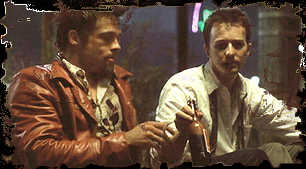 One thing that makes David Fincher such an influential filmmaker is obviously his visual style, but also the characterization of his protagonists and the antagonists is always refreshingly interesting. In every film, we get to see flawed personalities with edges and depth. Unlike what you would expect, the director leaves most of the control over these characters in the capable hands of his actors. “I think a movie’s casting is very important. You know, picking the right people for those particular parts,” he suggests. “I like to think of my job not as an actor. I can’t really image what it is like to be an actor,” he adds thoughtfully and with a healthy sense of understatement. “I would have to take acting classes. Their process is the inverse of the one I go through. Mine is to look at the macro, the whole puzzle, and focus on all the pieces. Actors on the other hand are looking at the one moment. They work on the one second, when someone says something their character has never heard before. They have to catch the crux of the narrative at any given time. It is very different from what I do as the director.”
One thing that makes David Fincher such an influential filmmaker is obviously his visual style, but also the characterization of his protagonists and the antagonists is always refreshingly interesting. In every film, we get to see flawed personalities with edges and depth. Unlike what you would expect, the director leaves most of the control over these characters in the capable hands of his actors. “I think a movie’s casting is very important. You know, picking the right people for those particular parts,” he suggests. “I like to think of my job not as an actor. I can’t really image what it is like to be an actor,” he adds thoughtfully and with a healthy sense of understatement. “I would have to take acting classes. Their process is the inverse of the one I go through. Mine is to look at the macro, the whole puzzle, and focus on all the pieces. Actors on the other hand are looking at the one moment. They work on the one second, when someone says something their character has never heard before. They have to catch the crux of the narrative at any given time. It is very different from what I do as the director.”
“My job is to be as helpful as possible so they don’t have to imagine as much. There are certain editorial functions you use. I don’t make them pause here and there, imposing on them how to do their job. They try to make something really real, and I try to capture that. It is my job to make the costumes work for them, to understand what they do at any given moment and to given them the freedom and flexibility to let them go with it. You could say that I create the laboratory, so they can spread like fungus… wildly.”
It had a certain “Twilight Zone” feel, and I loved that.
David Fincher about “The Game”
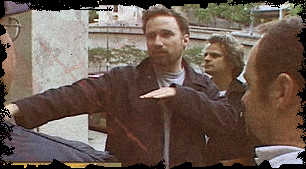 As anyone who has seen David Fincher’s films would be quick to attest, there is one common threat that can be found woven throughout his films. All of these stories have a rather dark, almost morbid, and fatalistic quality. It seems to completely contradict the friendly and soft-spoken person I am talking to, and I was curious to find out this was a coincidence or if David Fincher has a certain attraction to the fatalistic.
As anyone who has seen David Fincher’s films would be quick to attest, there is one common threat that can be found woven throughout his films. All of these stories have a rather dark, almost morbid, and fatalistic quality. It seems to completely contradict the friendly and soft-spoken person I am talking to, and I was curious to find out this was a coincidence or if David Fincher has a certain attraction to the fatalistic.
“I don’t know,” he replies after a short pause, then adding, “It may be me. I don’t find myself particularly fascinated with how badly people behave, but I do find it interesting on some level. In “The Game”, Michael Douglas’ character, Nicholas Van Orton, was actually a very sympathetic character. What I was most interested in this scenario however was the manipulation. It had a certain “Twilight Zone” feel, and I loved that. Am I attracted to the stories because they are fatalistic? I have to admit, I never really thought about it that much.”
Fincher’s latest film, “Fight Club” has raised quite a bit of controversy. It appears the film has split people right in the middle, and the box office numbers show that quite clearly. While some people love the film, others accuse it of being too violent and dark for its own good. Based on a novel by Chuck Palahniuk, who also co-wrote the movie’s script, the book had hardly ruffled any feathers and almost fell into obscurity. All this changed when the film got under way and people became increasingly aware of the story’s content. Still, Fincher never really expected that the project could create such a strong and vocal opinion.
“Call me naive, if you wish,” he admits, “I never thought it would be that controversial, really. Until it was finished. I never thought about it when I read the book.”
I don’t want to go out of my way to show a completely mockish self-serving thing
David Fincher about the criticism on “Fight Club”
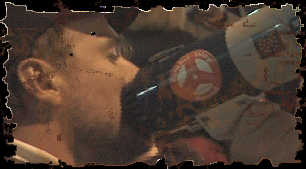 “Fight Club” is an observation of our material world that is pushing its own limits with every new product, every new commercial and every new face that is stylized as the new beauty ideal. “The movie is a social commentary,” Fincher explains to me. “It is very funny and absurd at times, and yet it is so true. I know that some people were really, really angry about this film, and some reviews stated something like “the director hates everyone in the movie,” which is absolutely not true. I just don’t think movies have to necessarily show the way we like to think we are. I don’t think we always have to agree with what we see. I don’t want to go out of my way to show a completely mockish self-serving thing. I believe the responsibility of a filmmaker is to offer alternatives.” It is an almost rebellious attitude that is rarely found in Hollywood these days, a world were all movies have to have happy endings, and where lives are glorified and stylized to the exact extremes that Fincher so successfully portrays in “Fight Club.”
“Fight Club” is an observation of our material world that is pushing its own limits with every new product, every new commercial and every new face that is stylized as the new beauty ideal. “The movie is a social commentary,” Fincher explains to me. “It is very funny and absurd at times, and yet it is so true. I know that some people were really, really angry about this film, and some reviews stated something like “the director hates everyone in the movie,” which is absolutely not true. I just don’t think movies have to necessarily show the way we like to think we are. I don’t think we always have to agree with what we see. I don’t want to go out of my way to show a completely mockish self-serving thing. I believe the responsibility of a filmmaker is to offer alternatives.” It is an almost rebellious attitude that is rarely found in Hollywood these days, a world were all movies have to have happy endings, and where lives are glorified and stylized to the exact extremes that Fincher so successfully portrays in “Fight Club.”
For the sake of making his point, Fincher went a very radical route in “Fight Club”, glorifying anarchy to extremes, ultimately to show us the failure of his main character—something he did deliberately. Fincher understands the story on a more philosophical level than it may be apparent at first.
 “The tale is really one of maturity,” he sums it up succinctly. “It is about a confused guy who tries to fit in this world that everyone else finds acceptable, but for him it just doesn’t work. So he casts off their ideals and enters the world that defines Tyler. Tylers says the only way to really experience life is to say to yourself, “God is dead!” and enjoy life. He builds his own religion around this, but ultimately this isn’t working either.
“The tale is really one of maturity,” he sums it up succinctly. “It is about a confused guy who tries to fit in this world that everyone else finds acceptable, but for him it just doesn’t work. So he casts off their ideals and enters the world that defines Tyler. Tylers says the only way to really experience life is to say to yourself, “God is dead!” and enjoy life. He builds his own religion around this, but ultimately this isn’t working either.
In the end, when the movie is over, he has learned a lesson and is ready to take his next step in life. He learned to make peace with the way things are in life. He realizes that life is not about killing off your ideals, and he begins to find his own. Marla, the woman he was so contemptuous of, suddenly becomes important to him. He learns that finally there is someone who understands him. Instead of hating her for reflecting himself, he realizes that he should have talked it out with her all the long.
Apart from creating his movies, David Fincher is also heavily involved in the video releases of his films. Immediately after finishing work on “Fight Club,” the director hooked up with New Line Home Video to work on a special edition release of his thriller “Se7en.” Technically extremely savvy, Fincher spend a lot of time to ensure the quality of the presentation of the movie on that DVD would be meticulous, and had a number of labs checked out to see how he could achieve the best possible look for the DVD. “Se7en” was relying heavily on the silver retention process that allowed for deepest blacks, and Fincher was determined to find a way to reproduce a look like this in the digital domain. However, instead of using a print that was treated for silver retention, he instead opted to have the film’s negative transferred and then do the adjustments digitally, so emulating the look of the chemical process.
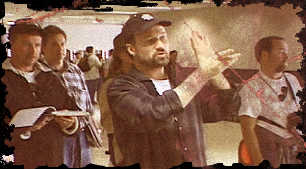 “We transferred “Se7en” from the original negative,” he fills me in. “Silver retention is necessary to make film look like it should look but doesn’t. Kodak makes such thin print stock these days because it is a lot cheaper. They run the [development] bath hot and very fast. What happens is that with this print stock they try to tweak every penny out of the process in the labs and in the end you get these incredibly thin film prints. It’s nothing like a 35mm slide. These prints are gray, they have no density and no saturation at all.”
“We transferred “Se7en” from the original negative,” he fills me in. “Silver retention is necessary to make film look like it should look but doesn’t. Kodak makes such thin print stock these days because it is a lot cheaper. They run the [development] bath hot and very fast. What happens is that with this print stock they try to tweak every penny out of the process in the labs and in the end you get these incredibly thin film prints. It’s nothing like a 35mm slide. These prints are gray, they have no density and no saturation at all.”
We just couldn’t get any prints that had blacks in it
David Fincher on the DVD for “Se7en”
If that sounds like words of frustration, believe me, they are, but Fincher is happy that he can circumvent these limitations for release of his movies on video. “The telecine process gives you a better version of the marginalized process. When you transfer to video you have the whole control over the picture’s gamma, the color saturation. You can gate how much limited information you have at the high and low end of the transfer.”
“When we started working on the DVD for “Se7en” just couldn’t get any prints that had blacks in it, although we underexposed a stop and a half. In all the labs we tried, the prints came out shoddy. They made fast and hot prints so they could get more stock through the machine. As a result, the print is has blacks that turn out green and gray. The Criterion Collection Laserdisc came from such a low cost print, but this time I talked to New Line and Michael De Luca was incredibly supportive, so we went for a high definition negative telecine transfer.”
As Fincher points out, the level of control you have over the picture in the digital domain is far superior than anything you could achieve chemically and has the added benefit that it can easily be adjusted on a frame by frame basis. “HiDefis incredible,” the director raves when he tells me about the result. “You can see things in that transfer that you can’t even see in the film’s release print. The level of detail is simply astounding.”
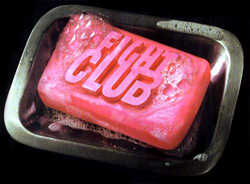 It is obvious from his remarks that David Fincher has a tendency to get very involved in the entire process of releasing his films to the home video market. “Fight Club” is a widescreen film in its truest sense—shot at a 2.40:1 aspect ratio that is turned into a 2.35:1 usable aspect ratio on TV because TV cuts off the edges, this is film you definitely do not want to see on a cropped pan and scan version.
It is obvious from his remarks that David Fincher has a tendency to get very involved in the entire process of releasing his films to the home video market. “Fight Club” is a widescreen film in its truest sense—shot at a 2.40:1 aspect ratio that is turned into a 2.35:1 usable aspect ratio on TV because TV cuts off the edges, this is film you definitely do not want to see on a cropped pan and scan version.
“I hate pan and scan,” David Fincher explains why he will always attempt to have his movies released in their original aspect ratios. “Movies are so complicated anyway. No matter how simple the idea itself is, with all the technical stuff surrounding it, it’s getting so complicated. Widescreen is the only way to watch movies. When you shot a movie at one aspect ratio and the go and say you will see only half of it on TV, it is just too much. The frame is designed to work under certain circumstances and changing these conditions, changes the entire movie.”
It is also noticeable from the wealth of behind the scenes footage that can be found on the DVD of “Fight Club” that Fincher is keenly aware of the demands for DVD releases in today’s marketplace. But unlike some other directors who hire dedicated cameramen to take footage on the set that can later be used for special editions, David Fincher likes a less intrusive way to obtain his material. John Dorsey was the movie’s associate producer and someone who is on the set all the time any way. Why not make use of such a valuable asset and have actual team members take the desired footage.
“Because John Dorsey was the project’s associate producer, he was all over the place anyway and knows everyone. I spend more time with John than with anyone else. John has this talent to become invisible. He has the camera, but I never see it. It is just there. I wouldn’t allow them to create Electronic Press Kits because I think they are horrible. With this, I thought, if anybody has to do this—and it was inevitable that we did—let John do it. He is invisible to everyone because you’re used to seeing him around all the time, and as a result, no one gets uptight.”
 As Fincher tells me the thought of having someone observing your every move can be something that seriously hampers the workflow, but with John Dorsey in tow, things went surprisingly smooth. “It can be very disconcerting to see yourself running around like a moron on that footage,” he offers.
As Fincher tells me the thought of having someone observing your every move can be something that seriously hampers the workflow, but with John Dorsey in tow, things went surprisingly smooth. “It can be very disconcerting to see yourself running around like a moron on that footage,” he offers.
Apart from the obligatory behind the scenes material there are also a number other ideas that can make for interesting additions to a movie. Additions that work their magic mostly when viewed repeatedly, such as on DVD. “I don’t think consciously, “that would be good for the DVD,” David Fincher remembers. “I like to make movies that people watch over and over again.”
“However,” he reveals with a smirk, “those single frame inserts in the beginning of the movie were really a DVD thing, because you can’t see it in the movie theaters.” Fincher is referring to individual, almost subliminal frames that have been inserted in the movie’s opening minutes. Like a figment of the viewer’s mind, Tyler Durden can be seen flashing the images for a split second, almost as an indication for things to come. To fully realize and appreciate these images it is obviously very helpful to have the ability to go through footage on a frame by frame basis, something DVD easily allows for.
To make sure the DVD ultimately turns out to be of the highest possible quality, 20th Century Fox Home Entertainment involved David Britten Prior as the producer for the special edition, who had seen bits and pieces of the film at Fox and got interested.
“I got involved in the project a couple of weeks before movie’s theatrical release,” he tells me. “I went to Fox for some other project and saw the film coming up on their release schedules. I have always been a fan of David Fincher and made a proposal to Fox, which they eventually accepted.
Interestingly, the DVD was originally planned as a standard day and date release without overly exciting special features, but soon these plans were changed in favor for the encompassing release we now see.
“The decision to make it a 2-disc box set came down fairly early in the process, if I remember right,” David Britten Prior explains. “The folks at Fox may have thought about it some time before they actually told me about it. For some reason, Fox became very supportive of the 2-disc format and they presented the idea to me. I remember now, it was very early in the development.”
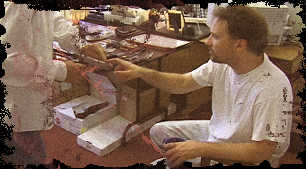 Due to this significant change in the scope of the project, the title was inevitably delayed and the release did not coincide with the VHS release of the film, as was originally anticipated. “I was just trying to get all the supplements together and it really wasn’t feasible to go day and date with this title. We could have raced through it, but it wouldn’t have been the way we wanted it,” he explains to me. “On top of that, if you work with people with Brad Pitt, they have a certain level of control over all the material, and they just need time to look over stuff.” Given the busy schedules of stars and other members who hove to sign off on DVD projects, this is hardly surprising, and Prior is at ease with the procedure. “It is part of the game,” he says, “and we always have to take into consideration that there has to be approval time. It was just a huge project.”
Due to this significant change in the scope of the project, the title was inevitably delayed and the release did not coincide with the VHS release of the film, as was originally anticipated. “I was just trying to get all the supplements together and it really wasn’t feasible to go day and date with this title. We could have raced through it, but it wouldn’t have been the way we wanted it,” he explains to me. “On top of that, if you work with people with Brad Pitt, they have a certain level of control over all the material, and they just need time to look over stuff.” Given the busy schedules of stars and other members who hove to sign off on DVD projects, this is hardly surprising, and Prior is at ease with the procedure. “It is part of the game,” he says, “and we always have to take into consideration that there has to be approval time. It was just a huge project.”
Prior recalls that putting together the material for the special edition was actually rather easy. “It wasn’t hard to get all the footage, really. What was hard, was to make sense of all of the material. We had hours and hours of special effects footage. There must have been 24 or 25 boxes full with all those video tapes, all kinds of tests, and other stuff. I knew what I wanted to do, but I did not know what I had. So going through this enormous amount of material was a challenge, it was really hard to make sense of it so we could present it in an entertaining and interesting fashion.”
What was hard, was to make sense of all of the material
David Britten Prior on the “Fight Club” Special Edition
When thinking of a 2-disc box set, one would assume that the release has enough storage space to accommodate anything the producers could possibly think up. As David Britten Prior tells me, this is not exactly right and if there was one big challenge in the creation of the “Fight Club” special edition, it was the fact that too much material had to be fit on these discs.
“The challenge was really twofold,” he recalls. “One was the sheer breadth of the commentary tracks. We had 4 separate tracks planned, featuring eleven people. Just creating and navigating through the schedule to record all these commentaries was tough but very well worth it. Particularly the writers’ track. I love all the commentary tracks on the disc, but usually you never get to hear the writer’s voice in such a context. It is weird, because they are such an important part of the whole process. The first thing that happens with any film, especially in this case, with a strong book, is that the writers go to work. To me, it felt wrong not to get them to talk about it.
Also, if you have a film that is as technically accomplished as “Fight Club,” we really couldn’t afford not to have the people talk about it that made it.
Eventually we lost a track with the Dust Brothers had to. It was not a scheduling problem or so, we ran out of space on the disc! It is really funny, because once Fox decided they wanted to have a second disc in the set, I was actually afraid I couldn’t fill it. It got to the point that I wondered, how I could possibly justify the second disc and then that.”
And then there was the controversy surrounding the release packaging. As you have certainly noticed from this interview, director David Fincher’s ambitions do not start and end supervising a film’s transfer. In the case of 20th Century Fox Home Entertainment’s recent release of “Fight Club,” the director also put in his weight to create the engrossing packaging for the DVD. After seeing a few suggestions from the studio, he got very blunt and pulled the brakes.
“If you stick this horrible VHS cover on the DVD, you won’t get a green light from me,” Fincher told Fox’s marketing people and gave them a good reason to come up with a radically new approach.
 Producer David Britten Prior also recalls the scenario and adds that he was glad, Fincher and he were in a similar mindset when it came to finalizing the packaging for the release. “He didn’t like the way DVDs are packaged, and neither did I,” he offers. “They tend to look a little generic and you just see a whole wall of look-alike DVDs when you go to a store. You just can’t tell one from another. Wanted one that stood out and was different. But we also wanted to make sure that thematically it feels like the film. The final idea was one of those things that came on rather early, but no one had the courage to really try it.”
Producer David Britten Prior also recalls the scenario and adds that he was glad, Fincher and he were in a similar mindset when it came to finalizing the packaging for the release. “He didn’t like the way DVDs are packaged, and neither did I,” he offers. “They tend to look a little generic and you just see a whole wall of look-alike DVDs when you go to a store. You just can’t tell one from another. Wanted one that stood out and was different. But we also wanted to make sure that thematically it feels like the film. The final idea was one of those things that came on rather early, but no one had the courage to really try it.”
The result is a wrapper box that looks like a stained brown paper bag. It contains the colorful and nicely arranged 2-disc set and catches one’s eye immediately. “I like this box,” David Fincher enthuses. “We wanted it to actually be a cardboard or paper wrapping with the string around. It turned out it wasn’t possible, but I really like the idea of the dirty bag.”
Well, to be honest, it works for me too…


Leave a comment
You must be logged in to post a comment.